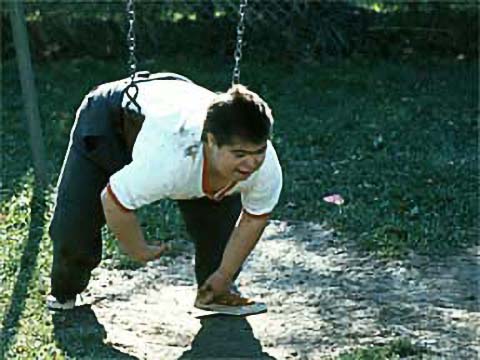Shifting the Focus from Placements to Teaching Strategies and Life Outcomes
Two conferences in 1975 and 1976 signaled a major shift in the approach to people with more severe* and profound disabilities*. In 1975, The Arc US, through a grant from the Bureau of Education for the Handicapped*, conducted a conference called "Educating the 24-Hour Retarded* Child". In 1976, the Council for Exceptional* Children published Hey Don't Forget About Me, the report of a conference about "education's investment" in people with severe*, profound* and multiple [disabilities]*.
Both conference reports presented some key concepts that would begin to help create a vision of a life of involvement and integration for children many thought required segregation. The focus turned to teaching functional and age appropriate skills.
Dr. Norris Haring spoke of functional curriculum – "time must not be consumed teaching responses, skills and facts that are not essential to increasing the independence of the child with severe disabilities*."

Photo courtesy William Bronston, M.D.
The New Behaviorism
Haring also acknowledged that the new behaviorism or the technology of behavior change has truly revolutionized the art of special education. At the same time, he raised a challenging question – "How can behavioral technologists apply their technology to an area which, as far as curriculum is concerned, is an uncharted wilderness?" That wilderness was teaching people with significant disabilities functional skills areas as self-feeding, toileting, dressing or walking.
Haring saw the need to develop curricula to teach people with significant disabilities basic skills, but also to help meet other important needs:
- to listen to parents.
- for skills and resources to insure the involvement of parents, administrators and the community in education.
- to train a new brand of teachers for these children.
- to understand what "ultimate role we have in mind for these children" and thus what kinds of skills they really will require.
- for the earliest intervention possible and for continuation of that intervention.
- for a drastic tooling up of the service delivery system to provide the intervention.
- for more research on all topics related to people with significant developmental disabilities.
- for support and commitment at all levels of government.
Dr. Lou Brown noted that "it is vital that public schools prepare students with severe disabilities* to function as independently as possible socially, vocationally and personally in the least restrictive post-school environment." And that we cannot justify "preparing students to function in large residential institutions or for fostering or maintaining the development of environments that unduly shelter or restrict the individual."

Dr. Norris Haring
The Criterion of Ultimate Functioning
For citizens with significant disabilities to ultimately function as productively and independently as possible in integrated adult environments, the services provided to them as students must be longitudinal and continuous, as opposed to short term and episodic.
The overuse of one to one instruction, homogeneous groupings, and repeated practice strategies probably prevent many persons with significant disabilities from acquiring the skills, values, and attitudes necessary to interact effectively in a variety of settings and with a variety of people.
Artificial instructional materials and settings do not allow students with significant disabilities to solve real life problems or provide them with the skills needed for practical functions, as much as do natural and realistic settings, tasks and materials.
In other words, the teaching of any specific skill must be justified by its ultimate contribution to the functioning of the individual in society. Teaching people to "walk in line" or to make pot holders would not contribute to their lives in the community.

Photo courtesy William Bronston, M.D.
Dr. Charles Galloway challenged the role of non-public education settings in "supporting an exclusionary and isolationist community policy toward a segment of the population."
Dr. Burton Blatt talked about the importance of supporting each individual "to realize his gifts, while society seeks to trap him, tame him and standardize him to fit society's picture of itself."
Victor Baldwin emphasized some key components of curriculum:
- The best curriculum in the world is worthless without a delivery system adapted to individualized student objectives.
- Task Analysis. Program implementers must analyze the task to be mastered, break it down into small sequenced components, and build as many branch steps on that level as are needed until the desired behavior is achieved
- When the teacher becomes a classroom manager, aides, volunteers, and paraprofessionals can play a key role in implementing the curriculum objectives.
- Generalization: Self care skills should occur in the most functional setting to insure generalization of the skills learned.
Such discussions also called for students to learn in age appropriate settings, heterogeneous groupings, and in natural proportions.

Photo courtesy William Bronston, M.D.
What does natural proportion mean?
The proportion of all people with disability labels in the general population is about 13% to 15%. People with the most significant disabilities represent less than 1% of the general population. When students with disability labels attend their home school, there is generally a natural proportion represented. School buildings should consider the natural proportion when assigning students to classrooms. Classrooms which consider the natural proportion will not have more than 15% of its members who have disability labels and no more than one of these students will have a label of significant disabilities.
What is an age-appropriate placement?
An age-appropriate placement refers to the general education classroom for students who are the same chronological age. For preschool-aged children, age-appropriate placements are the settings in which other children of their same chronological age attend.
What are homogeneous and heterogeneous groupings?
Homogeneous groupings refers to the practice of arranging instructional groups of children and youth based on an identified label. This practice is utilized in general education when children and youth are placed in "tracks" such as "basic," "average" and "accelerated." In special education, homogeneous groups are frequently formed based on disability labels. The premise behind the use of homogeneous groupings is that children and youth who are perceived to experience the same difficulties with learning should be taught together.
Heterogeneous groupings refers to a practice of arranging instructional groups to ensure that children and youth of diverse abilities are represented in each classroom and/or activity. The premise behind the use of heterogeneous groups is that children and youth of various abilities, talents and gifts benefit from learning together, by teaching and learning from one another.

Photo courtesy William Bronston, M.D.

Photo courtesy William Bronston, M.D.
Mainstreaming
It was during this period that the term mainstreaming became popular. Over the years, because mainstreaming has been used in many contradictory and incompatible ways, it is difficult to know what was actually meant by the phrase at any given time. Often, however, "mainstreaming" meant placement in general classes with little support.
When the Individuals with Disabilities Education Act (IDEA) was implemented in the 1977-1978 school year and until sometime in the mid-1980s, the term that described the education of students with disabilities with those who did not have disabilities was mainstreaming, defined as the educational arrangement of placing students [with developmental disabilities] in classes with their peers without disabilities to the maximum extent appropriate.
Typically, mainstreaming was implemented by having students with disabilities participate in the nonacademic portions of the general education program, such as art, music, and physical education. Other mainstreaming areas could include lunch, recess, library and computers. Some schools also mainstream into science and social studies.
The core subjects of language arts, reading and mathematics are typically not used for mainstreaming. Most students who are mainstreamed, however, are still enrolled in self-contained special education classes for academic core and non-core areas; they "visited" general education classes for a relatively small portion of time. For many educators and parents, mainstreaming provided far too little and came much too late for the students.

Photo courtesy William Bronston, M.D.
Another definition adds some other dimensions – who is "mainstreamed" with what expectations and which supports.
Mainstreaming was a term popularized after the passage of P. L. 94-142 which has been generally used to describe the process of placing a student with mild* to moderate* disabilities into one or more general education academic classes. Students who are mainstreamed are usually expected to meet the same standards as students without disabilities with minor modifications in curriculum or methodology. Prerequisite skills are generally felt to be necessary since the same standards for success are being applied for all students. This delivery model identifies the child as a "special"* rather than a "general" education student. This practice has not typically been associated with students who are identified as having significant disabilities.

Photo courtesy William Bronston, M.D.
